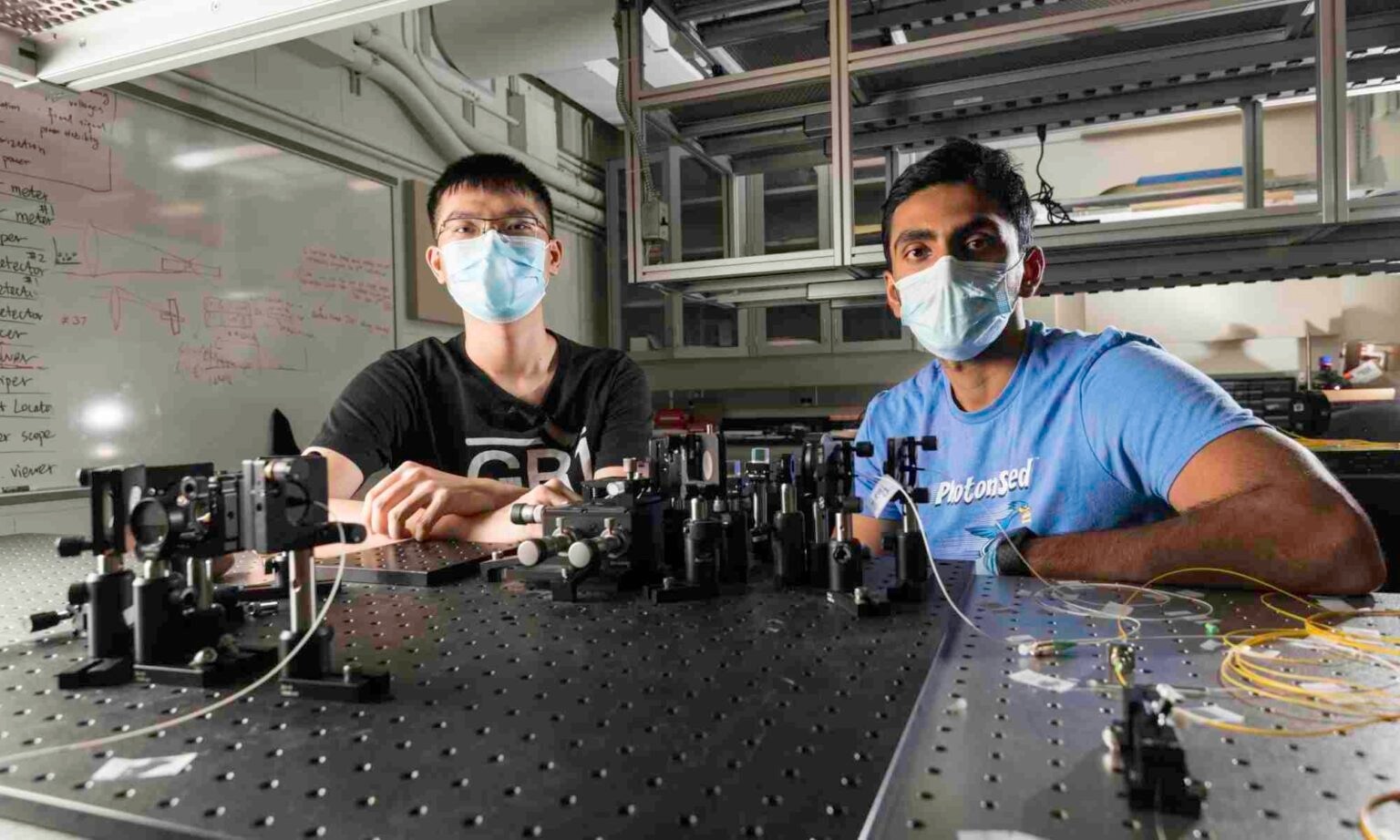When optical beams comprised of photons travel via fibers, they lead to vibrations that produce acoustic waves, consisting of phonons.

Optics PhD students Wendao Xu (left) and Arjun Iyer in the lab of optics professor Will Renninger in 2020. (University of Rochester photo/J. Adam Fenster)
The phenomenon, known as Brillouin scattering, has been bridled by scientists to optomechanically “couple” acoustic waves with light waves. This coupling enables data carried by photons to be transduced, or converted, to the phonons, which travel almost a million times slower compared to the light waves.
The availability of optoacoustic coupling has allowed scientists to read and manipulate the transduced information in a more simple manner. But, so far, several Brillouin scattering methods that have been utilized by researchers depend on standard fiber geometries that can result in acoustic waves dying out rapidly, thereby restricting the coupling efficacy.
At present, by making use of an optical fiber with a micron-sized waist, scientists from the University of Rochester have illustrated how to couple propagating optical waves and long-lived acoustic waves, consisting of powerful optical-acoustic interactions.
“This is a unique and desirable combination that has not previously been achieved,” says Wendao Xu, a PhD candidate in the research group of William Renninger, assistant professor at Rochester’s Institute of Optics. Xu is the lead author of a study in Optica explaining the discovery.
The discovery allows data carried by a light pulse to be stored temporarily in gradually propagating acoustic waves for a second pulse of light to “read” the information for a considerable time. The achievement could consist of applications for radio-frequency photonics filtering, light storage, and optical delay lines.
The study was granted Best Presentation Award at the WOMBAT 2022 Workshop on Optomechanics and Brillouin Scattering at the Max Planck Institute for the Science of Light, where it was presented by coauthor Arjun Iyer, also a PhD candidate in Renninger’s laboratory.
Wendao, Arjun, and our collaborators at the University of Tokyo did a great job in demonstrating the promise of this new platform and we are all excited as we begin focusing on next-generation devices and real-world applications.
William Renninger, Assistant Professor, Institute of Optics, University of Rochester
Brillouin scattering in optical fibers: overcoming difficulties.
The amplitude of the acoustic wave keeps decreasing as it travels. Basically, all the high-impact Brillouin scattering that people are dealing with right now produce strong interactions, but the acoustic waves are high in frequency, in the gigahertz range. The higher the frequency, the shorter the wave can actually travel before it dies out.
Wendao Xu, PhD Candidate, Research Group of William Renninger, University of Rochester
The tapered optical fiber device engineered by Xu helps achieve both longer acoustic lifetimes and powerful interactions. It comprises a multi-mode glass fiber with the cladding (coating) that has been eliminated.
While exposing the center of the fiber and concurrently applying mechanical tension to stretch the fiber at both ends, Xu and his collaborators were able to produce a closely confined, symmetrical “waist” present in the fiber.
This waist offers “an ideal optomechanical overlap yielding the strongest Brillouin coupling strengths observed to date from a fiber taper, and comparable to the largest optomechanical coupling strength for any system,” the study notes.
Furthermore, the lifetime of the phonons that have been generated by the device is nearly 2 μs. This is long enough that data carried by a light pulse can be stored temporarily in this gradually propagating acoustic wave for a comparatively long period of time, prior to a second pulse of light reading the information.
A Tapered Optical Fiber Device
As per Iyer, Xu’s achievement is double.
One is the system, the tapered fiber device, which supports an acoustic wave family that people didn’t pay a lot of attention to previously. The other is the process itself, using an interaction between two different optical spatial modes to get what we wanted.
Wendao Xu, PhD Candidate, Research Group of William Renninger, University of Rochester
According to Xu, the process—inclusive of the physics involved in achieving powerful interactions with long phonon lifetimes—can be adapted and applied instantly to enhance present technologies. For instance, detecting and filtering out undesirable radio frequencies in photonic filters, or generating fiber-optic transmission delays to redress for delay variations in optical fiber systems.
On the contrary, the tapered fiber system while beneficial for research is probably extremely fragile for real-world applications outside the laboratory, stated Iyer says. “These are micron-sized filaments of glass that are just hanging there,” adds Iyer.
But the scientists are already in search of ways to package the system for real-world applications, stated Iyer.
The other collaborators of the study include Lei Jin and Sze Y. Set at the Research Center for Advanced Science and Technology at the University of Tokyo.
The study was financially supported by the University of Rochester and the National Science Foundation. The University of Rochester’s Integrated Nanosystems Center offered expertise and assistance with the SEM (scanning electron microscope) characterization of the tapering device.
Journal Reference:
Xu, W., et al. (2023) Strong optomechanical interactions with long-lived fundamental acoustic waves. Optica. doi.org/10.1364/OPTICA.476764.